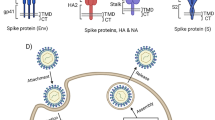Summary
The multiplication of parvovirus Lu III in asynchronously growing and synchronized HeLa cell cultures was followed by means of immunofluorescence staining, infectivity titration, hemagglutination assay, and pulse chase labeling for replication of viral DNA. Metabolic inhibitors were used to characterize the dependence of early intracytoplasmic and late intranuclear viral antigen formation on DNA as well as on RNA synthesis.
Formation of early intracytoplasmic antigen was not controlled by the actual status of cellular physiology and occurred at a maximum rate between 4 and 8 hours p.i. Only constant low levels of infective, hemagglutinating virus could be detected during that space of time. Synthesis of early antigen did not depend onde novo synthesis of DNA. proved to be unaffected byα-amanitin and rifampicin, but was reduced in the presence of 4 μg/ml actinomycin D.
After infection in early S phase, the amount of intranuclear viral antigen increased rapidly in synchronously growing cells from 10 to 12 hours p.i. Its appearance was well correlated with replication of viral DNA as well as with maturation of progeny virus which could be demonstrated as early as 8 hours following infection. Both inhibitors specific for DNA synthesis (FUdR, ara-C, mitomycin C) and those interfering with RNA synthesis (actinomycin D,α-amanitin, rifampicin) were able to prevent the accumulation of intranuclear antigen. The only specific action, however, could be ascribed to rifampicin, since all the other inhibitors used are known to block cellular metabolic activity as well and, hence, might have stopped the cell cycle already before the cellular helper function necessary in parvovirus replication was displayed. The results suggest that the helper function is available late in S phase of the cell cycle and obviously controls replication of viral DNA.
Similar content being viewed by others
References
Bretscher, M. S.: Direct translation of a circular messenger DNA. Nature (Lond.)220, 1088–1091 (1968).
Bretscher, M. S.: Direct translation of bacteriophage fd DNA in the absence of Neomycine B. J. molec. Biol.42, 595–598 (1969).
Cocuzza, G., andA. Castro: Rifampicin inhibits the multiplication of picodnaviruses RV and H-1. Boll. Ist. sieroter. milan.49, 179–181 (1970).
Cole, G. A., andN. Nathanson: Immunofluorescent studies of the replication of rat virus (HER strain) in tissue culture. Acta virol.13, 515–520 (1969).
Fields, H. A., andB. L. Nicholson: The replication of Kilham rat virus (RV) in various host systems: immunofluorescent studies. Canad. J. Microbiol.18, 103–107 (1972).
Franklin, T. J., andG. A. Snow: Biochemistry of Antimicrobial Action. London: Chapman and Hall Ltd., 1971.
Furth, J. J., andS. S. Cohen: Inhibition of mammalian DNA polymerase by the 5'-triphosphate of 1-β-D-arabinofuranosylcytosine and the 5′-triphosphate of 9-β-arabinofuranosyladenine. Cancer Res.28, 2061–2067 (1968).
Gamble, J. G., andR. H. McCluer:In vitro studies with rifampicin on the stability of heart mitochondrial RNA. J. molec. Biol.53, 557–560 (1970).
Grimley, P. M., andB. Moss: Similar effect of Rifampicin and other Rifamycin derivatives on vaccinia virus morphogenesis. J. Virol.8, 225–231 (1971).
Hallauer, C., G. Kronauer, andG. Siegl: Parvoviruses as contaminants of permanent human cell lines. I. Virus isolations from 1960–1970. Arch. ges. Virusforsch.35, 80–90 (1971).
Hallauer, C., G. Siegl, andG. Kronauer: Parvoviruses as contaminants of permanent human cell lines. III. The biologic properties of the isolated viruses. Arch. ges. Virusforsch.38, 366–382 (1972).
Ihler, G., andD. Nakada: Selective binding of ribosomes to initiation sites on single stranded DNA from bacterial viruses. Nature (Lond.)228, 239–242 (1970).
Jacob, S. T., E. M. Sajdel, andH. N. Munro: Specific action ofα-Amanitin on mammalian RNA polymerase protein. Nature (Lond.)225, 60–62 (1970).
Momparler, R. L.: Effect of cytosine arabinoside 5′-triphosphate on mammalian DNA polymerase. Biochem. biophys. Res. Commun.34, 465–471 (1969).
Mueller, G. C.: Biochemical events in the animal cell cycle. Fed. Proc.28, 1780–1789 (1969).
Price, R., andS. Penman: Transcription of the adenovirus genome by anα-amanitin-sensitive ribonucleic acid polymerase in HeLa cells. J. Virol.9, 621–626 (1972).
Reyes, P., andC. Heidelberger: Fluorinated pyrimidines: XXVI. Mammalian thymidylate synthetase: Its mechanism of action and inhibition of fluorinated nucleotides. Molec. Pharmacol.1, 14–30 (1965).
Seifart, K. H., andC. E. Sekeris:α-Amanitin, a specific inhibitor of transcription by mammalian RNA polymerase. Z. Naturforsch.24 b, 1538–1544 (1969).
Siegl, G., C. Hallauer, A. Novak, andG. Kronauer: Parvoviruses as contaminants of permanent human cell lines. II. Physicochemical properties of the isolated viruses. Arch. ges. Virusforsch.35, 91–103 (1971).
Siegl, G., C. Hallauer, andA. Novak: IV. Multiplication of KBSH virus in KB cells. Arch. ges. Virusforsch.36, 351–362 (1972).
Siegl, G., andM. Gautschi: The multiplication of parvovirus Lu III in a synchronized culture system: I. Optimum conditions for virus replication. Arch. ges. Virusforsch.40, 105–118 (1973).
Subak-Sharpe, J. H., M. C. Timbury, andJ. F. Williams: Rifampicin inhibits the growth of some mammalian viruses. Nature (Lond.)222, 341–345 (1969).
Tan, K. B., andB. R. McAulan: Effect of Rifampicin on poxvirus protein synthesis. J. Virol.6, 326–332 (1970).
Wells, R. D., andJ. E. Larson: Studies on the binding of Actinomyein D to DNA and DNA model polymers. J. molec. Biol.49, 319–342 (1970).
Williams et al.: In: International Virology 2 (J. L. Melnick, ed.), p. 306, Basel: S. Karger, 1972.
Author information
Authors and Affiliations
Rights and permissions
About this article
Cite this article
Siegl, G., Gautschi, M. The multiplication of parvovirus Lu III in a synchronized culture system. Archiv f Virusforschung 40, 119–127 (1973). https://doi.org/10.1007/BF01242643
Received:
Issue Date:
DOI: https://doi.org/10.1007/BF01242643




